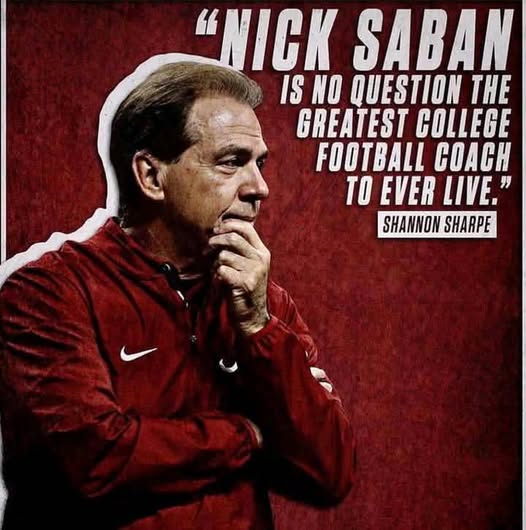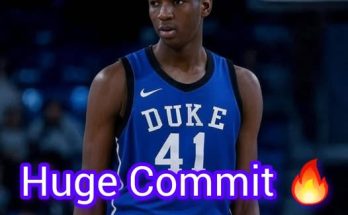In the pantheon of college football greats, only a select few names stir instant reverence: Bear Bryant, Knute Rockne, Urban Meyer, Tom Osborne, Bobby Bowden. Yet in recent years, the name Nick Saban has ascended to rarified air—becoming not only a symbol of excellence but the definitive standard-bearer in the sport. Now, as a new documentary titled Dynasty Forged: The Nick Saban Era premieres globally on streaming platforms, the sports world finds itself embroiled in a passionate debate: Is Nick Saban the greatest college football coach to ever live?
The question, once considered too grandiose to entertain while Saban was still roaming the sidelines at Alabama, is now being confronted with urgency. Fans, analysts, former players, and even rival coaches are weighing in, dissecting the legendary coach’s legacy with renewed vigor. And for many, the answer is not just yes—it’s unequivocal.
The Documentary That Reignited the Debate
Dynasty Forged opens with a panoramic view of Tuscaloosa, Alabama, on a crisp autumn morning. The camera pans to Bryant-Denny Stadium, its towering facade and sea of crimson and white serving as a cathedral to Saban’s greatness. The film, produced by ESPN Films in collaboration with Netflix Sports, chronicles every defining moment of Saban’s tenure at Alabama—from his shocking arrival in 2007 to his final championship in 2020, and the rippling legacy that still dominates college football.
Featuring exclusive interviews with Heisman winners like Mark Ingram and DeVonta Smith, NFL superstars like Tua Tagovailoa and Derrick Henry, and coaching disciples such as Kirby Smart and Lane Kiffin, the documentary paints a sweeping portrait of a coach whose fingerprints are embedded in every crevice of modern college football.
The timing of the release is poignant. With Saban now fully retired from coaching and focused on broadcasting and mentorship, the moment invites reflection not just on his career numbers, but on his towering influence over two decades of collegiate sports.
Seven National Titles: A Modern Miracle
At the heart of the argument for Saban’s GOAT status is a number that speaks louder than any superlative: 7 national championships. That figure places him ahead of Bear Bryant (6), Pop Warner (4), and even Rockne (3). And unlike some of his coaching ancestors, Saban did it in the modern era—a hypercompetitive landscape rife with scholarship limits, the transfer portal, social media distractions, and the gauntlet of the College Football Playoff.
Consider this: from 2009 to 2020, Alabama under Saban won six national titles in 12 seasons, an astronomical achievement that included perfect seasons, comeback victories, and even a last-second title win via freshman quarterback Tua Tagovailoa’s overtime strike in 2018. Saban’s only other championship came at LSU in 2003, proving his greatness was not tied to one program alone.
“He didn’t just win,” says Paul Finebaum in the documentary. “He redefined winning. He made 12-1 seasons feel like failure.”
The Coaching Tree That Shadows College Football
Saban’s dominance isn’t just measured in wins and titles—it’s visible every Saturday across the college football landscape. His coaching tree is arguably the most influential in NCAA history. Kirby Smart (Georgia), Steve Sarkisian (Texas), Lane Kiffin (Ole Miss), Jimbo Fisher (formerly Texas A&M), and even Mel Tucker and Mario Cristobal—each has led a Power 5 program, and each was mentored under Saban.
These proteges have adopted Saban’s meticulous attention to detail, ruthless efficiency, and relentless focus on “The Process,” a term that has become gospel in Tuscaloosa. That cultural shift—from focusing on outcomes to focusing on preparation—has transformed not only Alabama, but how the entire sport operates.
The Blueprint of a Dynasty
To fully grasp Saban’s impact, one must examine the structure he built at Alabama. The program wasn’t simply successful—it became a factory of excellence. From recruiting and player development to strength and conditioning and mental coaching, Saban established a system where every detail was optimized.
“He turned Alabama into the Google of college football,” says Bruce Feldman. “It became the place everyone wanted to be—not just players, but coaches, analysts, nutritionists. Everyone knew they were working for the standard.”
Saban’s recruiting acumen was also second to none. From 2008 to 2023, Alabama consistently signed top-five classes. He brought in future NFL stars year after year—Julio Jones, Amari Cooper, Minkah Fitzpatrick, Patrick Surtain II, and Will Anderson Jr., to name just a few. And more than that, he developed them into disciplined, elite players who understood both technique and team culture.
Cultural Resonance Beyond the Gridiron
What sets Saban apart, some argue, is that his impact transcended sport. He became a cultural icon—not in the brash style of a Deion Sanders or the theatricality of a Dabo Swinney, but through stoic excellence. In Alabama, he was more than a coach. He was a state figurehead, a stabilizing force in a region that needed something to rally around.
Saban’s foundation work, particularly through the Nick’s Kids Foundation, has donated millions to children’s hospitals, schools, and disaster relief efforts across the Southeast. He and his wife, Terry, became as much a part of the Tuscaloosa community as any elected official.
During times of national unrest—whether following the tornado that devastated Tuscaloosa in 2011 or during the peak of the COVID-19 pandemic—Saban’s voice was often a source of leadership and empathy. His weekly press conferences weren’t just watched for injury updates; they became philosophical treatises on work ethic, accountability, and character.
The Critics and Counterarguments
Not everyone is ready to crown Saban the unquestioned greatest. Detractors point out his struggles at the NFL level with the Miami Dolphins or his early inconsistencies at Michigan State. Others argue that comparing eras is futile, that coaches like Rockne or Bryant succeeded in times where building programs from scratch required innovation that Saban inherited.
And of course, there’s the debate around competition. Critics claim Saban benefited from resources at Alabama that most programs could never dream of, and the question looms: would he have achieved similar success in an era without the College Football Playoff or NIL deals?
But as ESPN’s Rece Davis notes in Dynasty Forged: “Every great coach had advantages. Bear Bryant had his. Urban Meyer had his. What Saban did was maximize his advantages better than anyone in history.”
Fans Speak: “The Standard by Which All Others Are Measured”
The final third of the documentary includes emotional testimonials from fans, many of whom have followed Alabama football for decades. One elderly man, tears in his eyes, reflects: “I saw Bear Bryant. I never thought anyone would top him. But Nick Saban… he changed what I thought was possible.”
Younger fans, too, have only known Alabama as a national powerhouse. For them, Saban isn’t just the past—he’s the baseline for success.
Social media exploded with commentary following the documentary’s release. On X (formerly Twitter), the hashtag #SabanGOAT trended worldwide. Sports personalities like Stephen A. Smith and Pat McAfee joined the debate, ultimately siding with Saban as the best ever. Even Tom Brady chimed in with a post: “Nick Saban = unmatched leadership and discipline. Nobody did it better. Period.”
A Legacy Cemented in Crimson
Nick Saban’s career is not just defined by victories, but by transformation. He changed how programs recruit, how players develop, and how coaches prepare. He reshaped expectations in Tuscaloosa and beyond. His emphasis on discipline, structure, and personal growth created not only champions, but generations of men molded by his leadership.
If football is about more than scores—if it’s about culture, resilience, and legacy—then the debate is closing fast. Nick Saban isn’t just a college football coach. He’s a mythic figure, a builder of dynasties, and quite possibly the greatest to ever walk the sideline.
As the documentary fades to black, the narrator leaves viewers with a haunting question: “In a sport defined by eras, what happens when one man becomes the era itself?



